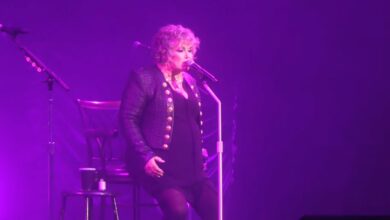The Paris Flash Mob That Turned “Bohemian Rhapsody” Into the Greatest Street Performance of All Time
Paris turned into an open-air theatre as thirty singers and musicians unfurled Queen’s “Bohemian Rhapsody” across a bustling city block, transforming everyday pavement into a full-scale performance space. Spearheaded by Parisian pianist Julien Cohen, the flash mob flowed from intimate piano ballad to towering operatic volleys and a jubilant rock finish, mirroring the song’s sectional architecture while keeping the spontaneity of street life intact. What began as a gathering of curious passersby quickly became a crowd bound by melody, surprise, and nostalgia—an urban pageant built around one of rock’s most audacious compositions and staged with uncommon musical discipline for a pop-up event.
The staging wrote a miniature film in real time. Shutters above a café swung open to reveal three singers starting the famous question, “Is this the real life?”, answered moments later by new voices emerging at street level. A pianist anchored the harmony while cameras panned to another window and then to a drum kit materializing in frame, tightening the groove. A blonde vocalist rolled past in a carriage to belt a verse, and an eleven-year-old stepped forward for the Brian May solo, folding delight into virtuosity. It felt scripted yet breathing, polished yet human, theatre disguised as everyday Paris.
The cast list explains why it sounded so convincing. Lead vocals were driven with showman flair by Mickey Callisto; guitars featured standout turns from GuitarOlly; the choral backbone blended pop voices and trained opera singers dispersed between windows and the square. The credits read like a miniature company: pop choir DDKN, counter-tenor Michael Konesaki, and a cluster of named opera voices coordinated around Cohen’s piano, then stitched together by careful edit and mix. This wasn’t a novelty singalong; it was an arranged street production aimed at honoring difficult music rather than reducing it to karaoke.
Musically, the risk was monumental. “Bohemian Rhapsody” vaults across discrete styles—lyrical ballad, mock-opera, hard-rock onrush, and a reflective coda—each demanding different phrasing, articulation, and mic strategy. In Queen’s arena shows, the operatic middle was historically handed to a prerecorded vocal stack while the band cleared the stage before re-entering for the rock explosion. This team attempted the harder road: distributing the choral lattice across live voices staged vertically and horizontally, using balconies as resonators and the street as a chamber. The result preserved intelligibility and drama without surrendering to playback.
The social design mattered as much as the harmony. Tourists, commuters, and café regulars coalesced into a single audience, reading the event as both civic gift and pilgrimage to a shared classic. Operatic timbres blooming from windows met pop belt and rock grit at ground level, echoing Queen’s original synthesis of high and popular art. The young guitarist in black high-tops embodied continuity—heritage carried forward with glee—while the carriage cameo winked at the song’s theatricality. What could have been spectacle landed instead as community ritual: a neighborhood briefly reorganized around melody, surprise, and the simple pleasure of singing together.
Virality followed because the package communicated instantly. Julien Cohen’s upload surged past half a million views within a day, then vaulted into seven figures as music sites amplified the clip and mainstream feeds picked it up. Coverage emphasized the project’s musical difficulty, the cast’s precision, and the clever geography of windows-to-street staging. By this weekend, the primary video had reached multimillion view counts on Cohen’s channel, a rare case where “flash mob” describes not gimmickry but a carefully executed arrangement that happens to unfold in public. The shareability rests on craft first, surprise second.
Watch the complete performance and pay attention to how spatial staging clarifies the operatic lattice, how crowd noise and mic placement become part of the mix, and how the cut pacing stays patient enough to preserve architecture as a musical partner. Note the lateral camera moves that “orchestrate” perspective—balcony to street like woodwinds to brass—before the hard-rock pivot lands and the square erupts into unison release. The link is here, placed after the sixth paragraph as requested, so you can analyze the edit, voicing, and environmental acoustics in context:
Context sharpens the significance. “Bohemian Rhapsody” turns fifty in October 2025, half a century after its October 31 release and nine-week reign atop the UK charts. Its structure still defies radio logic—no conventional chorus, modular sections stitched by theatrical instinct—yet its cultural gravity keeps deepening. Staging an all-live choral middle outdoors flips Queen’s touring workaround on its head and honors Mercury’s audacity with a community of voices. The Paris crowd wasn’t asked to sing along; instead, the city was asked to listen, then erupt, which is precisely what great public music does.
For Queen’s legacy, the flash mob underlines a central truth: these songs invite participation at scale. Mercury wrote parts that make ordinary bodies feel extraordinary—handclaps, vowels, and call-and-response that collapse distance. At Live Aid, “Radio Ga Ga” turned Wembley into a single instrument; in Paris, architecture took that role, with windows, façades, and stone reflecting a choir’s overtones into the street. Both gestures build temporary republics of attention where strangers synchronize breath and pulse, if only for six minutes and change. That is why this mattered: it created communion rather than cosplay.
Is it already the greatest flash mob of all time? Measured by musical difficulty, arrangement ambition, site-specific storytelling, audience enchantment, and replay value, it has a compelling case. Most flash mobs deliver a moment; this delivered a narrative arc with theatrical logic, linguistic clarity in the operatic volleys, jubilant weight in the rock riff, and a coda that exhaled ceremony instead of gimmick. Multiple outlets framed it as the most “insane” or “epic” street rendition yet, and the clip’s momentum suggests a durable afterlife—less a stunt than a model for how cities can host music that actually listens back.





